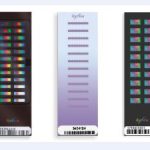
COI vs. Actual Heterozygosity – Demonstration #3
One question that has come up over and over again is “how do genetic diversity test results correlate with COI.”
The answer to that is that unless you are looking at large numbers or averages for a breed, they really don’t.
Breeders think of COI as a measure of inbreeding, and really it’s a probability calculation – the probability for an allele at a locus inherited from one parent to match precisely the allele at the same locus that is inherited from the other parent. On average, dogs with high COIs will be more homozygous than dogs with low COIs. So if you have nothing but pedigree information to go by, it’s better to have consistent low COIs than high COIs. Of course there are breeders who prefer high COIs and “nice tight breedings” but that’s another topic for a different post. However, whether doing a tight line breeding or a complete outcross, when you are breeding purebred dogs – or cats, or anything – the COI of any individual will tell you very little about that specific animal.
Before we talk about why that is, let’s look at two actual litters – an outcross and an inbreeding.
The first is the outcross. Both parents and 5 out of the 8 healthy puppies were tested. These are Standard Poodles, and thanks to the amazing resource of the Poodle Health Registry pedigree database, we know the COI for the litter is 2.3% for 10 generations, of which 9 generations are full, there are 865 unique ancestors and the pedigree is 98.3% complete. The COI is 4.7% for 15 generations, in which there are 4007 unique ancestors and it is 84.9% complete.
Internal relatedness or IR is a measure of inbreeding based on both homozygosity and allele frequencies. Homozygosity by Loci is another, different measure of inbreeding using both homozygosity and allele frequencies and the “percent homozygous” is simply the percentage of the tested loci that are homozygous. The statistics for the litter are here:
| none |
| none |
As you can see, the variation in that litter is huge. An IR value of 0.12 is quite high and an IR value of -0.13 is extremely low. This does not mean that the dog with 0.12 is somehow less valuable – because IR or homozygosity is not by any means the only measure of whether a dog is genetically valuable to a breed. In fact, in some cases a high IR makes it easier to decide on a mate, because when bred to a dog that is quite different, all the puppies will be very heterozygous. This also doesn’t mean that the low IR guarantees that a dog is genetically valuable to the breed. But it does mean the dog is far less at risk for recessive diseases, known and unknown, and less likely to produce these.
As for the litter as a whole, it’s important to note that the potential breeding analysis on Betterbred.com showed the average IR of this litter to be 0.02, and the range to be from -0.18 to 0.21, so the litter all fit within that. That average is slightly below the breed average of 0.03 and a good outcome. It’s still only useful as a concept, since depending on which puppy someone picks, they could have an outbred dog or an inbred dog.
So let’s look at a different breeding – an accidental inbreeding by the same sire – to his litter sister.
| none |
| none |
Now no one is suggesting that this is a great idea, but most breeders have said that inbreeding is not a bad thing and most researchers think close inbreeding is crazy. As you can see, they are both right, depending on the puppies kept for breeding. One of these puppies is extremely inbred, with an IR value of 0.48, while another is only highly inbred, but not shockingly so, at 0.17 and one of them is well within a normal range at 0.07. That low IR puppy with a 27.9% COI actually has a lower IR than some of its half-siblings in the 2.3% COI breeding. Now before anyone questions the parentage, when this litter was originally run, the researchers also questioned the parentage, and the DNA on the parents was doublechecked and confirmed to be right. The potential breeding estimate on BetterBred.com shows the estimated litter average to be 0.25, with a minimum IR of -0.03 and a maximum of 0.54.
How does this relate to COI? Well according to the COI, you could easily select puppies from either of the litters that was well correlated the COIs of the litter, but you are MORE likely to have picked puppies from the litter that were NOT well correlated with the COI. The range of difference in these litters is reflective of the incredible variation promoted by natural reproductive processes. Even in close breedings, it is possible to select for heterozygosity.
But you can’t see it for sure from the outside of the puppy.
Typically, show or conformation breeders look for puppies that will grow up to be preponent and this usually means they tend to pick the more homozygous puppies. How do we know that? Two ways – first, it’s what the research indicates, and second, most conformation traits – visible traits – that breeders select for are recessive, which means they work only when homozygous. So if you want a breed with 5 homozygous traits, like color and coat, or some basic size or shape related traits, the chances of you picking a puppy with more homozygosity than heterozygosity are much higher. You might pick a puppy with all those recessive traits that is not homozygous across the board, but you’ll have to get lucky. This is why inbreeding works well for conformation-focused lines. The more homoygous a dog is, the more likely they are to have certain desireable visible traits.
Working lines, and working dog subpopulations often inbreed as well. But research has proven that working lines retain more heterozygosity. Why? Because complex traits require many genes in one dog to be strong trait. These are not recessive traits, requiring the same allele at the same locus, but rather many different genes throughout the DNA. You need proper structure and intelligent and specific instincts, but many working lines don’t care if the ear set is right or the color is perfect. So when looking for a performance or working dog, the chances of the most promising puppy being more heterozygous is much higher. It’s not always the case, but the more heterozygous a dog is, the more likely they are to have certain desireable complex traits.
It is important to note that heterozygosity vs. homozygosity is not the only factor to consider when assessing genetic diversity data. There is another important piece of information, and that is the Outlier Index (OI). How genetically different a dog is from its breed is also an important aspect of selecting your next generation, and for that consideration, it’s crucial to know how much population-wide historical inbreeding is in the breed. If the breed has had a significant genetic bottleneck that has resulted in most of the dogs being genetically very similar, then the OI value of a dog is very important. If the breed has retained a well distributed diversity, then the IR value is more important.
In order to use these methods, your breed needs a full breed analysis, and each breed is different. If you are interested in enrolling your breed, you can learn more about it from UC Davis’ Veterinary Genetics Lab. If you want help with the project, you can email admin@caninediversity to explore ways BetterBred.com can assist you.
 Previous Post
Previous Post Next Post
Next Post


